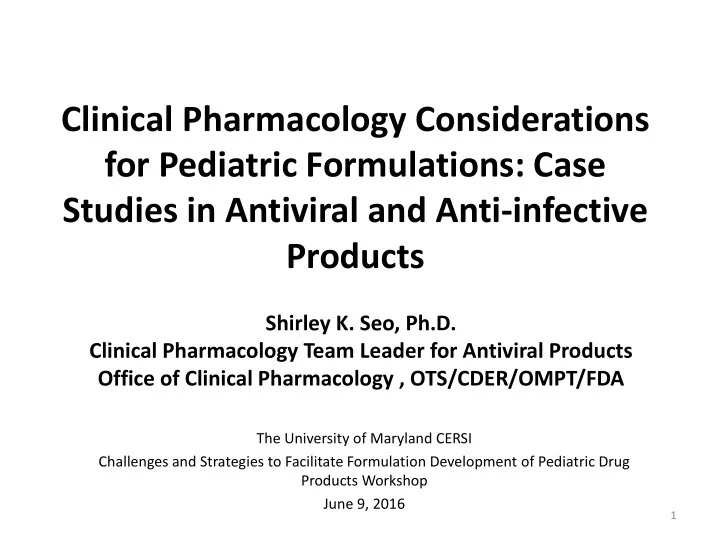

Clinical Pharmacology Considerations for Pediatric Formulations: Case Studies in Antiviral and Anti-infective Products Shirley K. Seo, Ph.D. Clinical Pharmacology Team Leader for Antiviral Products Office of Clinical Pharmacology , OTS/CDER/OMPT/FDA The University of Maryland CERSI Challenges and Strategies to Facilitate Formulation Development of Pediatric Drug Products Workshop June 9, 2016 1
Disclaimer • The opinions expressed in this presentation are my own and do not necessarily represent the views of the FDA. 2
Introduction A lot of work in advancing drug development in pediatrics has been initiated/done: – Two laws (PREA and BPCA) have been enacted and reauthorized that will continue to increase the number of studies conducted in children – Progress in the areas of biomarkers, PK-PD relationships in children, in silico modeling have all contributed to a greater understanding of response to treatment in children 3
Introduction But a lot of work is still left to be done! You are here Formulation issues remain a challenge for many pediatric programs… 4
The Ideal Formulation • The ideal pediatric formulation should: – have non-toxic excipients • Amprenavir case—propylene glycol – allow for flexible titration of dosing • Limited for fixed dose combinations – be stable in various light, humidity, and temperature conditions • Extemporaneous formulations – be palatable • Powder formulations—have you guys tried this stuff? – be easy to administer • Haha, yeah right 5
Pediatric Formulation Issues -have translatable bioavailability between adults and pediatrics • Lamivudine case: 6
Translation of Relative Bioavailability Scenario 1 Scenario 2 Scenario 3 ADULTS ADULTS ADULTS Formulation Formulation Formulation Formulation Formulation Formulation A B A B A B PEDIATRICS PEDIATRICS PEDIATRICS Formulation Formulation Formulation Formulation Formulation Formulation A B A B A B Assumption This could be an issue This could be OK 7
Lamivudine • The ARROW trial (conducted in Africa) offered a rare opportunity to obtain BA comparison data in children in a PK substudy: – children with HIV-1 infection weighing 12 to <15 kg – had been taking zidovudine, lamivudine, and abacavir oral solutions during the trial and were ready to switch from oral solution to tablet formulations – intensive PK assessments while children were on oral solution and then again after the switch to tablet 8
Lamivudine • Results showed divergence from what was previously known about bioavailability of solution vs. tablets in adults – Peds: 37% lower bioavailability for the solution as compared to tablet – Adults: BE shown in NUCA1003 in 12 HIV-infected adults, with GMR (90% CI) for tablet vs. solution being 0.98 (0.98–1.00) for AUC 0– ∞ and 0.98 (0.98– 1.01) for Cmax 9
Lamivudine • From section 12.3 (under Special Populations): “The relative bioavailability of EPIVIR oral solution is approximately 40% lower than tablets containing lamivudine in pediatric subjects despite no difference in adults. The mechanisms for the diminished absolute bioavailability of lamivudine and relative bioavailability of lamivudine solution are unknown.” 10
Current Paradigm 11
Extemporaneous Formulations for Pediatric Patients • Why/when used? – An age-appropriate formulation is needed for pediatric patients (i.e., oral solution or suspension) and one is not commercially available – Alternatives may be too cost-prohibitive • How? – In some instances, the information is found in the USPI – Otherwise, USP monographs or published references • Clinical pharmacology considerations? – At times, a relative BA study is not conducted; assumed to be similar between the solid oral dosage form and the extemporaneous formulation 12
Valacyclovir • One example of detailed instructions for an extemporaneous formulation being contained in a drug’s USPI 13
Vancomycin • USPI for Vancomycin HCl for injection, fliptop vial. Contains instructions for making an oral formulation. 14
Conclusions (my soap box) • Pediatric formulations present unique challenges to drug development • A lot of progress has been made; even more is needed (particularly in the area of prediction) • Recognizing where the challenges and areas of need are, is the first step in making further progress 15
Questions? 16
Recommend
More recommend